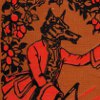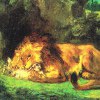



|
|
Title | Aesop's Fables
| |
Author | Aesop
| |
Illustrated By | John Fitz Jr.
| |
Publisher | John C Winston Company - 1928
| |
First Printing | ---
|
|

|
|
Title | Aesop's Fables
| |
Author | Aesop
| |
Translator | V.S. Vernon Jones
| |
Cover Art | Eugene Delacroix
| |
Illustrated By | Arthur Rackham
| |
Publisher | Collector's Library - 2006
| |
First Printing | ---
|
| |
|
Category | Children
| |
Warnings | None
| |
Main Characters | Too many to list
| |
Main Elements | Fable, anthropomorphism
| |
Website | Available on Project Gutenberg
|
|

(*)This timeless collection bring together three hundred of the most popular of Aesop's fables in a collection that will delight young and old readers alike. Here are all the age-old favorites - the wily fox, the vain peacock, the predatory cat and steady tortoise - just as endearingly vivid and relevant now as they were for their very first audience. While their lifespan over several millenia marks them out as one of the most enduring staples of world literature, they have also been the inspiration for countless other forms of narrative in various languages. For all their entertainment value - this is a world where every lamp and the moon can speak, and mice taunt bulls - they have also come to be fondly regarded as a playful compendium of secular wisdom.
Although the three hundred fables in this collection are attributed to Aesop, and his name is synonymous with the form, it seems unlikely he was anything more than a legendary figure. While some historical accounts maintain he was a slave with a prodigious talent for storytelling who lived during the sixth century BC, many believe it unlikely that this whole collection of fables can be attributed to one individual. What does seem clear though is that the fables began their life being transmitted orally before being put down in writing.
(*)From the Collector's Library edition

You can download a multitude of editions from Project Gutenberg as well as on sites like Aesop's Fables - Online Collection. A little bit of online research will find a lot of controversy as to which fable really should be attributed to Aesop and which should not. Both my collections contain the Milkmaid and the Pail which apparently only came about in the Middle Ages, the same with the Wolf in Sheep's clothing. In fact people are pretty sure there's no Aesop to begin with. Just as no one is really sure if Shakespeare wrote all, if any, of the plays attributed to him. After all, with nearly 700 fables handed down orally over generations, not only would it be near impossible to trace their origins, but even confirm how accurately they survived the retelling. I noticed distinct differences in how my two editions translated the fables, in some cases giving very different impressions!
But who wrote them shouldn't take away from the fable themselves.
There were all the old favorites, like the Tortoise and the Hare, as well as many I had never heard before or had long forgotten. Each of them has a moral associated with them, though sometimes it isn't so clear what the point was. However both books were a pleasure to read. One was an old book from my father's high school so I have a great nostalgic attachment to it, the other was one in a collection of classics from one publisher that I've been attempting to collect the entire set. But either way, reading a few fables here and there was enjoyable, sometimes made you laugh, sometimes made you think, and somethings made you feel ashamed as you found yourself reflected in the characters that got what they deserved!
|











